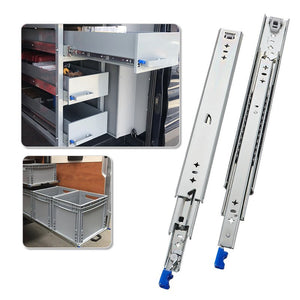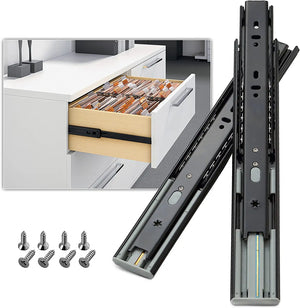Introduction
The role of drawer racks in every well-organised kitchen is often overlooked, but they play a vital role in the smooth running of your kitchen. Whether you're refurbishing your kitchen or just looking to upgrade your drawer racks, this comprehensive guide will walk you through the process step by step. We know that installing drawer racks can be a daunting task, but fear not, we're here to simplify it for you.

I. Gather Necessary Tools and Materials:
Preparation is Key Before you dive into fitting your new kitchen drawer runners, let's make sure you have all the tools and materials you need. Here's what you'll require:
- Drawer runners (of course!):The star of the show! These are the sliding mechanisms that allow your drawers to move smoothly in and out. Ensure you've selected the right type and size for your kitchen cabinets.
- Screwdriver:A Phillips-head or flat-head screwdriver will be necessary for fastening screws during the installation process.
- Measuring tape:This tool is vital for measuring the precise locations where you'll be installing the drawer runners. Accurate measurements are crucial for a seamless fit.
- Pencil:You'll need a pencil for marking the positions where the drawer runners will be installed. Marks can be easily erased or adjusted as needed.
- Spirit level:To ensure your drawer runners are installed perfectly level and plumb, a spirit level (also known as a bubble level) is indispensable. It helps avoid tilting or misalignment.
- Screws:Depending on the type of drawer racks you're installing, you'll need the right screws to secure them firmly to the cabinets and drawers. Be sure to use the correct size and type.
- Drill:If your installation requires drilling holes for screws or adjusting existing holes, a drill is essential. Ensure you have the right drill bit for the job.
- Drawer front (if you're replacing it):If you plan to replace the drawer front, have the new front panel ready. Ensure it matches the style and dimensions of your existing cabinet design.
II. Remove Old Drawer Runners (if applicable):
If you are replacing an existing drawer rack, first empty the drawer and fully extend it. Inside the drawer, locate and inspect the mounting screws that hold the old runners in place. Using a suitable screwdriver, carefully remove these screws so you can remove the old runners from the drawer. Similarly, look for the screws that attach the old runners to the cabinet frame or sides and remove them. Make sure to check the drawers and cabinets for any remaining hardware. Finally, measure and record the location of the holes before disposing of the old runners. These measurements are critical to properly aligning the new runners during installation. This process ensures a smooth transition to the upgraded hardware.

III. Measure and Mark:
Now, let's be precise. Measure and mark where you want to install your new drawer racks. Remember, precision is key to making sure the drawers go in and out smoothly.
IV. Install the Drawer Runners:
Attaching the New Runners It's time to attach the new runners. Follow these steps:
-
Position the Runners: Begin by positioning the drawer runners inside the cabinet. You'll typically have one runner mounted on each side of the cabinet, parallel to each other. Make sure they are aligned correctly and level.
-
Mark the Screw Holes: Using a pencil or a marker, mark the locations of the screw holes on the cabinet's interior. These marks will serve as your guide for drilling pilot holes for the screws.
-
Drill Pilot Holes: With the positions marked, use an appropriately sized drill bit to create pilot holes at the marked locations. Pilot holes are essential as they prevent wood from splitting when you insert the screws.
-
Attach the Runners to the Cabinet: Place the drawer runners back into position, aligning them with the pilot holes. Secure them to the cabinet using screws. Ensure that the runners are firmly attached and level. Be cautious not to overtighten the screws, as this could strip the holes or cause misalignment.
-
Attach the Runners to the Drawer: Now, focus on attaching the other ends of the runners to the sides of the drawer. The process may vary depending on the type of runners you have. Common attachment methods include screws or brackets. Follow the manufacturer's instructions for your specific runners, ensuring proper alignment and secure attachment.
-
Test the Drawer Operation: After installing the runners, test the drawer's operation by sliding it in and out. Ensure that it moves smoothly and without any obstructions. If you encounter any issues, such as sticking or misalignment, make the necessary adjustments.
-
Fine-Tune for Alignment: To achieve perfect alignment, you may need to make minor adjustments. Check for vertical, horizontal, and front-to-back alignment. Adjust the runners as needed to ensure the drawer sits correctly within the cabinet.
-
Double-Check Fasteners: Before considering the installation complete, double-check all screws and fasteners to ensure they are securely tightened. Loose fasteners can lead to wobbly or misaligned drawers.
V. Test the Drawer Operation:
Smooth as Butter With your runners installed, it's time to test the drawer's operation. Open and close it several times to ensure it moves smoothly. If you encounter any issues, don't worry; we'll address them.
VI. Adjust for Perfect Alignment:
Fine-Tuning For perfect alignment, you might need to make minor adjustments. Here's how:
- Adjust the runners vertically, horizontally, or front-to-back to ensure your drawer sits just right.
VII. Secure the Runners:
Locking it in Place Once everything is aligned perfectly, secure the drawer runners firmly in place. Double-check all screws and fasteners to ensure stability.

VIII. Install the Drawer Front:
Completing the Look If you've replaced the drawer front, attach it securely to the drawer. Pay attention to alignment and maintain even spacing for a polished look.
IX. Final Testing and Troubleshooting:
Addressing Common Issues Give your drawer one final test to make sure everything is in working order. If you encounter problems like misalignment or difficulty in closing the drawer, don't worry; we've got solutions for you.
X. Maintenance and Care:
Keeping it Running Smoothly To ensure your kitchen drawer runners have a long life, follow these maintenance tips:
-
Regularly check for any loose screws or issues.(Have your trusty screwdriver ready. Start by opening the drawers completely. Check all the screws that hold the drawer shelves to the cabinets and drawers. If you notice any of the screws have become loose over time, use your screwdriver to gently tighten them. Be careful not to over-tighten as this can cause damage. After tightening any loose screws, test the operation of the drawer to ensure it still moves smoothly. If you experience any difficulties, recheck the installation procedure and calibration.)
- Lubricate the runners if they start to feel sticky or resistant.(To properly lubricate your drawer racks, follow these steps:Start by choosing a suitable lubricant, such as a silicone-based or Teflon-based option, while avoiding oils or greases, which attract dust and dirt. Next, make sure the drawer racks are thoroughly cleaned, removing any debris or residue with a soft cloth or brush and ensuring they are completely dry. Apply a small, even amount of the selected lubricant along both sides of the runners. Then, operate the drawer several times so that the lubricant is evenly distributed and penetrates the moving parts. Test the smooth operation of the drawer and, if necessary, recheck the installation and alignment. Finally, wipe off any excess lubricant with a clean cloth to prevent sticky residue build-up and ensure optimum performance in the operation of your drawer.)
Conclusion
As you've discovered, installing kitchen drawer slides isn't as daunting as it may seem. With the right tools, careful measurements, and a little patience, you can enjoy smooth drawer operation in your kitchen. Remember, proper installation is key to kitchen functionality, and it all starts with your drawer racks.
Now, head over to our website, AOLISHENFG, for a wide selection of drawer runners to enhance your kitchen's organization and functionality.





